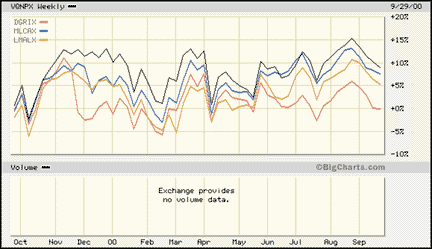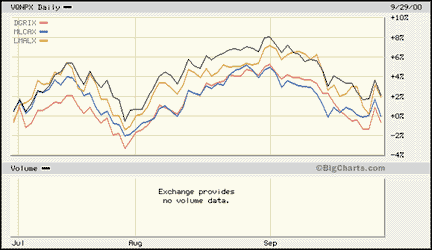
HOT TOPICS LIST
- Strategies
- Stocks
- Buy
- Investing
- Brokers
- Psychology
- Interviews
- Accumulate
- Sell
- Hold
- Spotlight
- Websites
- Candlestick Corner
- Gold & Metals
- Options Trading
LIST OF TOPICS
MUTUAL FUNDS
Shopping For Fund Fees
11/22/00 03:18:58 PM PSTby Han Kim
There's no free lunch, even with the least expensive of mutual funds. Find out what your service fees are for -- and whether you are paying too much for lackluster returns.
| Some people always seem to find the best deals around. These consumers get the lowest prices because they know what they want and they shop around until they find it -- at the best price. Likewise, when you shop for mutual funds, take a close look at the bottom line. High performance is important, but you also want the fund with the best price -- the one that reduces your returns the least. Mutual funds charge fees, loads, and transaction costs, all of which reduce your returns. It's easy to overlook these fees now, but paying too much in fees -- especially with an underperforming mutual fund -- can turn a good investment return into one that is barely above average, or worse. MUTUAL FUND COSTS Two types of cost are associated with mutual funds: transaction fees and operating fees. These fees are paid when an investor makes a change in the fund. A transaction fee is charged when an investor purchases additional shares, sells shares, or moves monies from one fund to another within the same mutual fund family. Typically, transaction fees only apply to load funds (mutual funds that charge a front-end sales load), though many no-load funds charge some sort of redemption fee when investors sell shares. This cost is intended to limit "fund-hopping," or short-term buying and selling of shares in mutual funds. A front-end sales load, sometimes referred to simply as a "load," is charged whenever an investor buys shares in the fund. These fees range from zero, in the case of no-load funds, to as high as 8.5% of the initial investment. Conversely, investors pay a back-end load (also known as a "deferred sales charge") whenever they sell shares from their mutual fund. Not all mutual fund companies use back-end loads; some companies use them instead of front-end loads, and others reduce or even eliminate back-end loads, depending on how long an investor has held shares with the fund. Redemption fees are another type of back-end charge. Often, in order to advertise themselves as no-load mutual funds, some mutual fund companies charge a redemption fee when investors sell their shares instead of a back-end load -- even though both serve the same purpose. Back-end loads and redemption fees are both disincentives for overly anxious investors who move in and out of mutual funds as if they were stocks. The last type of transaction expense is the exchange fee, which investors pay when they move from one fund in a fund family to another. While not nearly as frowned upon as "trading" mutual funds, transferring money from one fund to another does incur administrative costs that the exchange fee is used to cover. These are expenses incurred during the normal maintenance of the fund. They include expenses for everything from management and research to advertising and marketing. Unlike transaction fees, which are charged directly to investors, operating expenses are periodically taken from an investor's fund account. As such, operating expenses are expressed as a percentage of the investment's net worth. Some of the most common operating fees are management fees and 12b-1 fees. Management fees are exactly that. They reflect the amount the fund's advisor gets for managing the mutual fund. Management fees usually run between 0.5% and 1% of the investor's assets in the fund and, like back-end loads, may be reduced as the investment size grows. Of particular interest are 12b-1 fees. Due to the popularity of mutual funds -- and the accompanying competition -- many mutual funds spend significant amounts of money advertising and marketing their funds and fund managers. Enter the 12b-1 fee. Named after the Securities and Exchange Commission (SEC) rule that granted mutual fund companies the right to charge them, 12b-1 fees go toward advertising the mutual fund as well as any related sales and marketing costs. These fees cannot exceed 0.75% of the total assets of an investment. Different mutual fund companies may charge other fees -- special transfer fees, for example, or accounting fees. But all operating fees charged by mutual fund companies are usually combined to derive an expense ratio, which is key for mutual fund investors to see exactly how much of the return on their investment has been consumed by the fees for running the fund. IMPACT ON FUND PERFORMANCE This is not to suggest that fees are bad -- at least, no more than taxes are. But when comparing the various touted returns on different mutual funds, the investor who does not take a close look at the fee structure underlying those returns can be in for a rude awakening when the mutual fund statement arrives. Here's why.
The return figures are one-year annualized returns as of September 30, 2000. While the actual implementations of a growth and income strategy may vary, growth and income mutual funds generally seek to combine capital appreciation with preservation strategies for investors preferring limited risk exposure. Which fund would you choose?%A0 The Vanguard Growth and Income fund stands out as a clear winner, with the highest return of the group and the lowest expense ratio. This is often the case when funds do well; in fact, even high-expense funds can do well when their underlying portfolios advance strongly. Over the course of a year, a 16% return is not bad at all. But what happens when the returns are not so stellar?%A0 Consider the performance of the same funds during a different period -- that is, the past three months (again, as of September 30, 2000). (See Figure 2.) What a difference a down quarter makes!
Something else should be kept in mind about expenses and fees. The effect of some fees can be mitigated by your strategy. Back-end loads and redemption fees, for example, are less of a concern for a long-term, buy and hold investor who does not plan to redeem shares until retirement. For an investor who makes infrequent additions to his or her mutual fund (annually or quarterly, for example), front-end loads are not as costly as they might be for someone regularly purchasing shares (say, on a monthly basis). THE GOOD NEWS The good news: you have options! Fees vary from one fund to another, as well as from one fund family to another. Keep in mind you should compare the fees and expenses of like funds; the fees and expenses of an actively managed mutual fund investing in smaller-cap companies in emerging growth countries should not be compared with the fees of a mutual fund indexed to the Standard & Poor's 500. Different types of mutual funds generally have different expense ratios because of the differing objectives between funds. Now that you know the fees behind the funds, shop around and keep those expenses in mind. Choose a mutual fund that will yield healthy returns, one whose fees will not reduce performance. | ||||||||||||||||||||||||||||||||||||||||||
Staff Writer
| Title: | Webmaster |
| Company: | Technical Analysis, Inc. |
| Address: | 4757 California AVE SW |
| Seattle, WA 98116 | |
| Phone # for sales: | 206-938-0570 |
| Fax: | 206-938-1307 |
| Website: | working-money.com |
| E-mail address: | hkim@traders.com |
Traders' Resource Links | |
| Charting the Stock Market: The Wyckoff Method -- Books | |
| Working-Money.com -- Online Trading Services | |
| Traders.com Advantage -- Online Trading Services | |
| Technical Analysis of Stocks & Commodities -- Publications and Newsletters | |
| Working Money, at Working-Money.com -- Publications and Newsletters | |
| Traders.com Advantage -- Publications and Newsletters | |
| Professional Traders Starter Kit -- Software | |
PRINT THIS ARTICLE

|

Request Information From Our Sponsors
- StockCharts.com, Inc.
- Candle Patterns
- Candlestick Charting Explained
- Intermarket Technical Analysis
- John Murphy on Chart Analysis
- John Murphy's Chart Pattern Recognition
- John Murphy's Market Message
- MurphyExplainsMarketAnalysis-Intermarket Analysis
- MurphyExplainsMarketAnalysis-Visual Analysis
- StockCharts.com
- Technical Analysis of the Financial Markets
- The Visual Investor
- VectorVest, Inc.
- Executive Premier Workshop
- One-Day Options Course
- OptionsPro
- Retirement Income Workshop
- Sure-Fire Trading Systems (VectorVest, Inc.)
- Trading as a Business Workshop
- VectorVest 7 EOD
- VectorVest 7 RealTime/IntraDay
- VectorVest AutoTester
- VectorVest Educational Services
- VectorVest OnLine
- VectorVest Options Analyzer
- VectorVest ProGraphics v6.0
- VectorVest ProTrader 7
- VectorVest RealTime Derby Tool
- VectorVest Simulator
- VectorVest Variator
- VectorVest Watchdog


